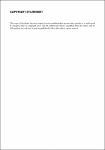The Postnatural Animal in Contemporary Art
| dc.contributor.supervisor | Drayson, Hannah | |
| dc.contributor.author | Finnegan, Paul | |
| dc.contributor.other | School of Art, Design and Architecture | en_US |
| dc.date.accessioned | 2023-05-12T13:05:23Z | |
| dc.date.available | 2023-05-12T13:05:23Z | |
| dc.date.issued | 2023 | |
| dc.identifier | 10432409 | en_US |
| dc.identifier.uri | https://pearl.plymouth.ac.uk/handle/10026.1/20884 | |
| dc.description.abstract |
The thesis uses art practice as a research method to propose novel characterisations of animal life. These characterisations aim to challenge an organicist image of non-human animals. The thesis considers animal bodies and behaviours as subject to aesthetic judgments that are underpinned by deeper ontological and epistemological commitments as to relations between nature and society, in which to be categorised as the former entails a series of privations in relation to the latter – the absence of freedom, subjectivity and creativity. Scholarly research on the history of the perception and conception of animal life within modernity, and subsequent challenges made to these within the contemporary humanities and contemporary art support and inform the practical enquiry. The thesis draws primarily here upon new materialist and post-humanist-oriented animal studies, and on scholarship surrounding the contemporary French artist, Pierre Huyghe. Positing the Anthropocene as a condition in which the distinction between human history and natural history has collapsed, the thesis argues for disassociating the concept ‘animal’ and the concept ‘nature’. The thesis attends to entanglements of animal worlds and cultural tropes where this equation fails. It proposes an an-organic and dis-harmonious animal life that attest to the end of nature and witnesses the dissonant and incomplete conditions of modernity. Both the written argument and the artistic outcomes propose novel ways to consider animals in relation to visuality. The thesis takes bio-art (i.e., art practice that incorporates living organisms) as of methodological value in this project where it engages the potentiality of animals themselves to challenge a received historical status. Furthermore, art practice is not just seen as a vehicle for depicting animal futures, but as a condition for liberating animals from nature. The thesis thus equates the postnatural animal with their becoming agents within artworks. | en_US |
| dc.language.iso | en | |
| dc.publisher | University of Plymouth | |
| dc.rights | CC0 1.0 Universal | * |
| dc.rights.uri | http://creativecommons.org/publicdomain/zero/1.0/ | * |
| dc.subject.classification | PhD | en_US |
| dc.title | The Postnatural Animal in Contemporary Art | en_US |
| dc.type | Thesis | |
| plymouth.version | publishable | en_US |
| dc.identifier.doi | http://dx.doi.org/10.24382/5037 | |
| dc.rights.embargoperiod | No embargo | en_US |
| dc.type.qualification | Doctorate | en_US |
| rioxxterms.version | NA |
Files in this item
This item appears in the following Collection(s)
-
01 Research Theses Main Collection
Research Theses Main



